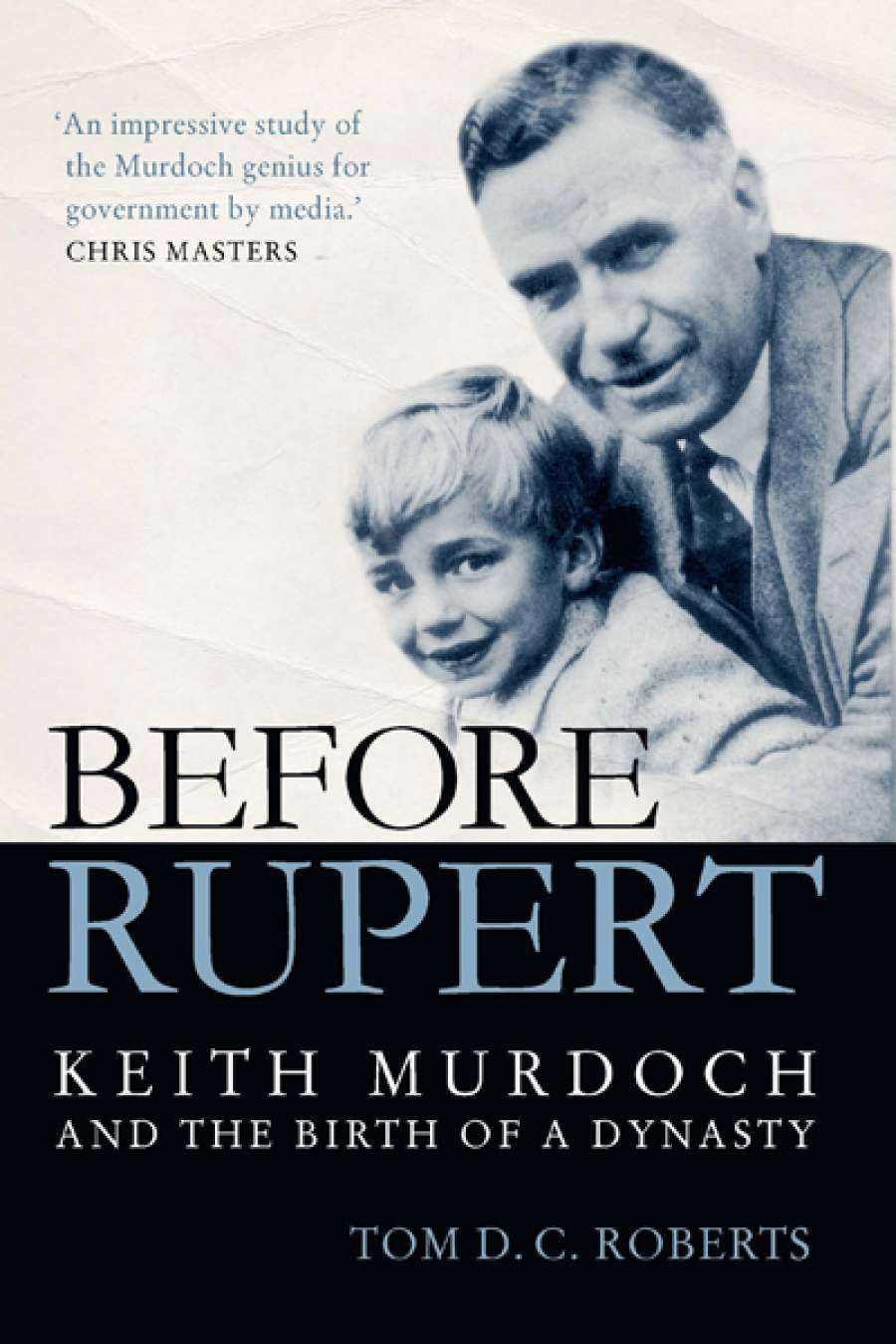
- Free Article: No
- Contents Category: Media
- Custom Article Title: Paul Morgan reviews 'Before Rupert' by Tom D.C. Roberts
- Review Article: Yes
- Online Only: No
- Book 1 Title: Before Rupert
- Book 1 Subtitle: Keith Murdoch and the Birth of a Dynasty
- Book 1 Biblio: University of Queensland Press, $34.95 pb, 392 pp, 9780702253782
Roberts's main interest is Murdoch's place in the history of twentieth-century media. Murdoch was a born newspaperman. As a teenager, he joined The Age and spent five years as a suburban reporter, hampered by a stammer which often forced him to write notes to communicate. Yet he was persistent, ambitious, and an instinctive networker. After the Gallipoli letter, Murdoch returned to Australia as a redoubtable force. As editor of the Herald, he transformed the paper, drawing on the example of his mentor, Lord Northcliffe. 'We want crime, love, excitement, and sensation,' announced Murdoch, who was soon dubbed Lord Southcliffe. He was a strategic buyer of other titles, and introduced 'controlling shares' (a practice still used at News Corp). Picture content was boosted; beauty contests appeared in his Sydney and Melbourne papers. He devised a way to print advertisements across two pages. He even found time to prepare an analysis of different italic typefaces for his papers.
The 1920s were a time of rapid technological change, with films and air travel and cables flashing messages around the world. An excited Murdoch seized upon their relevance to his media operations. One of the country's first radio stations broadcast from the Herald and Weekly Times building, cross-promoting his newspapers. He was outraged by competition from the ABC, a rage maintained by his family. At his death he had plans to establish Australia's first television station.
Murdoch was on fire in those interwar years. A founding member of the AJA, he later created AAP, which he chaired for five years. He sent Roy Morgan to study with Gallup in the United States with a view to bringing opinion polls to Australia. Murdoch became convinced that Australia needed its own newsprint industry. He funded research into making paper from eucalyptus, and established Australian Newsprint Mills.
 Keith Murdoch (National Library of Australia, via Wikimedia Commons)
Keith Murdoch (National Library of Australia, via Wikimedia Commons)
Murdoch was rightly viewed as a peer of Lords Northcliffe and Beaverbrook, and William Randolph Hearst (the model for Orson Welles's Citizen Kane). These were the men who realised that control of information and public opinion is a fulcrum to influence government. 'My circulation is the proof that I represent public opinion,' said a satirist of the day. Murdoch would not have disagreed. He made himself useful to powerful men, creating a pattern of obligation. During World War I he worked on behalf of Billy Hughes to influence opinion in favour of conscription. In one fabricated story, he described German 'corpse factories' where dead soldiers were recycled into margarine. Murdoch had a compulsion to meddle in affairs of state. With Charles Bean he conspired to stop John Monash (the 'pushy Jew') from being made commander of Australian forces. For years to come he had influence at the highest levels, as the 'backseat driver' of Australian politics. Joseph Lyons was called 'the best Prime Minister Keith Murdoch ever had'.
'Murdoch was rightly viewed as a peer of Lords Northcliffe and Beaverbrook, and William Randolph Hearst'
'Keith's early recognition of the ascendancy of the media to its position of pivotal power in the modern world was inspired,' writes Roberts. This was his greatest legacy – one which his son built on, culminating in the dubious spectacle of Fox News.
Murdoch himself remains obscure: as with Kane, his 'Rosebud' is yet to be discovered. He could be ruthless, a bully, a liar, a racist, an anti-Semite. Yet Elisabeth Murdoch (a teenager when they met) found him a shy man. Convinced of his ugliness, he eschewed photographs and portraits. Presbyterian prudishness was combined with a relish for salacious stories. He was an important patron of the arts. The influential 1939 Herald exhibition of modern art, which introduced Australia to works by Picasso, Dalí, Gauguin, and others, was entirely his conception.
Keith Murdoch was a dynamo in Australian public life and left a legacy which continues to reverberate today. Roberts has done a service to Australia with this authoritative and fascinating biography.


Comments powered by CComment